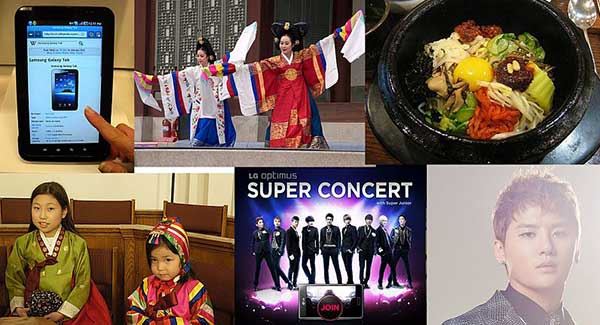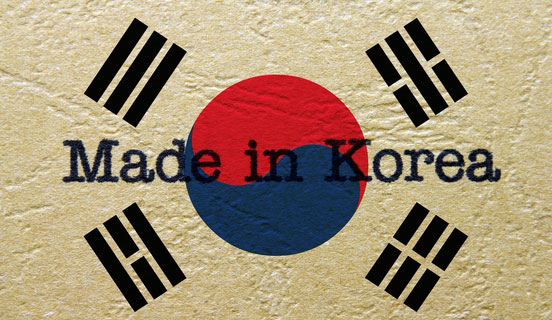
Kyoto Review of Southeast Asia Issue 11 (March 2011): Southeast Asian Studies in Korea
Development of the Korean Wave
Since the late 1990s, an increasing amount of Korean popular cultural content including television dramas, movies, pop songs and their associated celebrities have gained immense popularity across East and Southeast Asian countries. News media and trade magazines have recognized the rise of Korean popular culture in Asia by dubbing it the ‘Korean wave’ (Hallyu in Korean). The Associated Press reported in March 2002: ‘Call it “kim chic”. All things Korean–from food and music to eyebrow-shaping and shoe styles–are the rage across Asia, where pop culture has long been dominated by Tokyo and Hollywood’ (Visser, 2002). According to Hollywood Reporter, ‘Korea has transformed itself from an embattled cinematic backwater into the hottest film market in Asia’ (Segers, 2000).
Yet about a decade ago, Korean popular culture did not have such export capacity, and was not even critically acclaimed by scholars. For example, the 1996 edition of The Oxford History of World Cinema did not make any reference to Korean cinema, although it paid tribute to Taiwanese, Hong Kong, Chinese and Japanese films (Nowell-Smith, 1996). Korean music was also ignored by researchers, as can be seen in the following comment in World Music: The Rough Guide published in 1994: ‘The country has developed economically at a staggering pace, but in terms of popular music there is nothing to match the remarkable contemporary sounds of Indonesia, Okinawa, or Japan’ (Kawakami and Fisher, 1994).
Therefore, even the Koreans did not initially believe the news of Korean popular culture being popularly consumed overseas. For example:
What the so-called Bae Yong Jun fandom (or, “Yon-sama syndrome”) in Japan may cause an average Korean citizen like me to feel would be “puzzled pleasure”…. While we feel proud of ourselves, the long-time cultural importer, having become a cultural exporter, we are puzzled as to what in our culture is enchanting the foreigners. (Lee, 2004)
The above quote from a current affairs magazine nicely depicts Koreans’ reaction to the Korean Wave phenomenon. Korea has long waged a struggle for cultural continuity, confronted by a series of threats of foreign cultural domination. Because of deep-seated “underdog” consciousness in terms of cultural exchanges, it was not easy for them to believe the news of Korean Wave phenomenon.
It is reported that the Korean Wave started in China sometime around 1997 when the Korean television drama What is Love All About? made a huge hit after its broadcast on the China Central Television Station (CCTV). It recorded the second-highest ratings ever in the history of Chinese television (Heo, 2002). Following this unexpected performance, a series of other Korean dramas have captivated Chinese audiences. Since then, Korean television dramas have rapidly taken up airtime on television channels in countries such as Taiwan, Singapore, Thailand, Vietnam and Indonesia which saw media liberalization beginning in the 1990s. In addition, the Asian economic crisis in the late 1990s brought about a situation where Asian buyers preferred the cheaper Korean programming; Korean television dramas were a quarter of the price of Japanese ones, and a tenth of the price of Hong Kong television dramas as of 2000 (Lee, 2003). Korean television programming export figure has increased so dramatically that in 2007, it reached US$150.95 million, from US$12.7 million in 1999 (Ministry of Culture and Tourism, 2008).
Films and songs from Korea also accompanied the popularity of Korean television dramas across Asia. For example, the boy band H.O.T. found itself topping the pop charts in China and Taiwan in 1998; the band was so popular that album sales continued surging for a while even after the band’s break-up in mid 2001. In 2002, Korean teenage pop sensation BoA’s debut album reached the number one spot on the Oricon Weekly Chart, Japan’s equivalent of the American Billboard Charts (Visser, 2002). The songs and dance moves of Korean girl bands such as Wonder Girls and Girls’ Generation are so popular in Cambodia and Thailand these days that a lot of fans and local singers there are imitating them. From the late 1990s, Korean films have also received critical acclaim and drawn large audiences across Asia.
Against this backdrop, Korean stars have made a big impact on the consumer culture, including food, fashion, make-up trends, and even plastic surgery. It is not uncommon to find Asian youth decorating their backpacks, notebooks, and rooms with photographs of Korean stars. So popular are Korean actresses Lee Young-ae, Song Hae Gyo, Kim Hee Sun and Jeon Ji-hyun that it has been reported that their wanna-bes in Taiwan and China request for their facial features when going for cosmetic surgery (Joins.com, 2001; Straits Times, 2002a and 2002b). With the report that several Korean actress have had their faces ‘enhanced’, women from China, Vietnam and Singapore are flocking to Korea to have their faces cosmeticized by the Korean surgeons. It is now called the Korean Wave in plastic surgery (Kim Chul-joong, 2009).
Given their infatuation with Korean culture, the overseas fans are eager to learn the Korean language and travel to Korea. For example, the number of the Test of Proficiency in Korean (TOPIK) takers around the world have increased to 189,320 in 2009 from 2,692 in 1997 largely because of the interest generated by Korean television dramas (Yi, 2009). Travel agencies around Southeast Asia sell television drama-themed group tours to Korea. Thanks to the Korean Wave, the Korea National Tourism Organization (KNTO) has been planning to develop travel programs in order to have more inbound tourists.
The growing popularity of Korean pop culture has more implications than simply earning foreign currency, especially considering that the country has had some diplomatic friction with its neighbours in the past decades. The Vietnamese still vividly remember that Korean soldiers fought against their Liberation Army during the Vietnam War. The Taiwanese have felt betrayed by Korea ever since Seoul suddenly severed its diplomatic relations with Taipei in order to establish new ties with Beijing in 1992. In this vein, Korean pop stars have contributed to improving Korea’s foreign relations. In one instance, Korean actor Jang Dong-gun and actress Kim Nam-ju enjoyed such popularity in Vietnam that the Vietnamese even labelled them their ‘national’ stars. The then Korean President, Kim Dae Jung, even invited the pair to the dinner he hosted for Vietnamese President Tran Duc Luong when the latter visited Korea on 23 August 2001 (Australian, 2002). BoA, who made the cover of the French Le Monde in July 2002 as an icon of cultural exchange between Korea and Japan, was invited to the two countries’ summit conference in June 2003 in Tokyo (Macintyre, 2002). In all, Koreans have heartily welcomed the fruits of the Korean wave in the midst of economic recovery from the 1997 economic crisis, and the subsequent International Monetary Fund (IMF)-directed economic restructuring, which they often refer to as ‘national humiliation’.
Research of the Korean Wave
The Korean Wave research in Korea has largely focused on the development of such phenomena in China and Japan. There are several reasons for this. Firstly, the Korean Wave started largely in China; secondly, China is the biggest and potentially the most profitable market for Korean Waverelated products; and finally, Japan is the richest consumer market in Asia. As such, while there is an excitement among the Koreans about the Korean Wave news, the number of research on the Korean Wave in Southeast Asia is smaller than that in East Asia. In this situation, Shin and his associates’ (2006) edited volume of the Korean Wave in Southeast stands out. In the book, Asian studies scholars on Singapore, Thailand, Vietnam, Japan, etc have described and analyzed the development of the Korean Wave in each Asian countries. Other than that, Shim (2007) has done research on the development of the Korean Wave in Singapore and its impact on the Korean housewives’ lives in a foreign land. He argues that the phenomenon has empowered Korean women in their relations with both the husbands at home and foreigners outside their homes. Shin and a Thai scholar Siriyuvasak (2007) have traced Thai youth’s consumption pattern of the K-pop and revealed the Thai concern about the cultural McDonaldization or standardization as a result of the Korean Wave in Thailand.
The Korean Wave phenomenon has stimulated Korean scholars to re-examine the notion of one-way flow of globalization (Kim Sujeong 2009; Jeon and Yoon 2005). For one, Shim (2006) argues that there are roughly three strains of globalization discourse. The first approach views globalization as an outgrowth of cultural imperialism following the New World Information and Communication Order (NWICO) discussions of the 1970s. According to this approach, forces of globalization are usually American, and they subjugate weaker, national/cultural identities. While this approach has retained considerable resonance within the political discourse of developing countries, especially with the rise of foreign television programming in their territories, it has fallen under scholarly critique as being overly simplistic (Chadha and Kavoori, 2000; Morley and Robins, 1995). In fact, it is no longer the case that a one-way flow of Western media content exists due to the increasing contraflow in international media such as the Korean Wave, and growing plurality of regional media players based on what Straubhaar (1991) calls the ‘cultural proximity’ factor. In addition, this approach has missed the complexity of audience reception of media content (Wasko, et al., 2001). Finally, there is a danger of romanticism and fetishism of ‘national’ culture (Morris, 2002).
In the second view, globalization is understood as an outcome of the workings of modernity project (Giddens, 1991). According to Tomlinson (1991), it is ‘the spread of the culture of modernity itself. This is a discourse of historical change, of “development”, of a global movement towards … capitalism’ (p. 90). This argument is already visible in Weber’s (2000) idea that capitalism is a natural extension of the progress of reason and freedom associated with the Enlightenment. In more recent sociological studies, Harvey (1990) and Jameson (1996) argue that humanity has entered into a new historical epoch since the 1970s (from modernity to postmodernity; from capitalism to late capitalism), made possible by the development of new technologies. Some political economists critique this notion by arguing that the conflation of modernity with capitalism is wrong. According to Wood (1998), when 18th century French bourgeoisie–supposedly the source of the modernity project–fought against the aristocracy, they fought for universalism and human emancipation. On the other hand, the main aim of capitalism is not the improvement of humanity, but the improvement of property. Therefore, if capitalism has anything to do with modernity, it is that capitalism has destroyed modernity. Wood argues that the geographic term ‘globalization’ is imperfect as a description of and explanation for the present era. It is better characterized as the universalization of capitalism, when capitalism has penetrated into every aspect of life, society and culture. In a similar vein, McChesney (1998) criticizes the notion of globalization as an outcome of modernity because it tends to provide an aura of ‘inevitability’ to the rise of neoliberalism and concentrated corporate control of (and hyper-commercialization of) the media in the present era.
In the third approach are discourses that identify the cultural hybridity and investigate into power relations between periphery and centre from the perspective of postcolonial criticism (Kraidy, 2002). Paradoxically, globalization encourages local peoples to find the ‘local’ that they have neglected or forgotten in their drive towards Western-imposed modernization during the past decades (Featherstone, 1993; Robertson, 1995). There are two distinct modes of re-localization in non-Western political and cultural formations. While some forces and groups–such as Hindu nationalists in India, and the Taleban in Afghanistan–campaign for a return to the imagined ‘good old days’, others–such as Asian tiger economies–revisit or strengthen their own developmental routes by embracing and utilizing the new glocal economic situation. In this transnational context of a meeting between the periphery and the centre, hybridity reveals itself as new practices of cultural and performative expression. For example, locals appropriate global goods, conventions, and styles including music, cuisine, cinema, fashion, and so on, and inscribe their everyday meaning into them (Bhabha, 1994).
Scholars who are interested in finding out the internal factor for the Korean media development relies on the hybridization theory. In this regard, Shim (2006) pays attention to the ‘crisis consciousness’ among the Korean policymakers and media industry in the period of late 1980s and early 1990s. Under the U.S. pressure, in 1988 the Korean government allowed Hollywood studios to distribute films directly to local theatres; since then, more than ten Korean film importers had shut down their businesses by 1994. This market opening to Hollywood majors affected the vitality of the local film industry in general, such that the number of films produced annually fell from 121 in 1991 to 63 in 1994. In 1994, Hollywood’s market share in the local market reached 80%, from 53% in 1987 (Shin, 1995; Yi, 1994). Therefore, Korean cinema, which had already been ignored by local audiences who considered it poorly made, boring, and often maudlin, was drawing its last breath.
In the face of a possible erosion of their cultural particularity, Korea made every effort to strengthen their cultural industries. In this process, cultural hybridization has occurred as local cultural agents and actors interact and negotiate with global forms, using them as resources through which Koreans construct their own cultural spaces. By this, we understand that the globalization, particularly in the realm of popular culture, breeds a creative form of hybridization that works towards sustaining local identities in the global context.
The development of Korean media industries and their advancement into regional markets is clearly a sign of resilience of the subaltern, and of contamination of the imperial, considering the decades-long context of American domination over global cultural industries. However, the Korean Wave phenomenon provides us with two different questions. Firstly, some Asian countries view that the Korean Wave is another form of cultural imperialism. Secondly, how can we induce the energy from the Asian craze over the Korean popular culture to form the emotional energy to build up East Asian community? Hong Kong-based film critic Law has the view that Korean popular culture’s success arises from its ability to touch the right chord of Asian sentiments, such as family values (Chon, 2001). According to Iwabuchi, regionally circulating popular cultural products provide ‘a sense of living in the shared time and common experience of a certain (post)modernity which cannot be represented well by American popular culture’ (2001, p. 56). As to the extent that audiences derive similar identities from watching the same programs, is it also possible to think of ‘imagined communities’ in Asia?
SHIM Doobo
Sungshin Women’s University
This article is largely a summary and reprint from the author’s 3 previous papers: 1) Shim, D., “Hallyu as an international communcaition phenomenon and hybridity,” in Program/Text 11, 65-85 (2004) (in Korean); 2) Shim, D., “Hybridity and the rise of Korean popular culture in Asia,” in Media, Culture and Society 28 (1): 25-44 (2006); 3) Shim, D., “The growth of Korean cultural industries and the Korean wave,” in East Asian Pop Culture, edited by Chua Beng Huat and Koichi Iwabuchi, p. 15-31. Hong Kong: Hong Kong University Press, 2008.
—References:
Anonymus. 2001. A Pop Culture Wave Rolls. 10 September 2001. Internet souce:
http://www.joins.com (accessed 22 January 2002).
. 2002. Suddenly, All Things Korean are Chic. The Australian, 28 January: 36.
. 2002. Taiwan women hanker after Korean looks. Straits Times, 12 March.
. 2002. China girls seek surgery to look like Korean stars. Straits Times 5 August.
Bhabha, H. 1994. The Location of Culture. New York: Routledge.
Chadha, K. and A. Kavoori. 2000. Media Imperialism Revisited. Media Culture and Society 22(4): 415-432.
Chon, G. 2001. Golden Summer. Asiaweek, 26 October: 46-49.
Featherstone, M. 1993. Global and Local Cultures. In Mapping the Futures: Local Cultures, Global Change, edited by J. Bird, et al., pp. 169-187. London: Routledge. Giddens, A. 1991. Modernity and Self-Identity. Oxford: Polity.
Harvey, D. 1990. The Condition of Postmodernity. Oxford: Blackwell.
Heo, J. 2002. The “Hanryu” Phenomenon and the Acceptability of Korean TV Dramas in China.
Korean Journal of Broadcasting 16(1): 496-529.
Iwabuchi, K. 2001. Becoming “Culturally Proximate”: The A/scent of Japanese Idol Dramas in Taiwan. In Asian Media Productions, edited by B. Moeran, pp. 54-74. Richmond, UK: Curzon.
Jameson, F. 1996. Five Theses on Actually Existing Marxism. Monthly Review 47(11): 1-10.
Jeon, Gyu-chan and Yoon, Tae-jin. 2005. Realizing the Korean Wave into an Asiatic cultural flow. Korean Journal of Broadcasting 19(The International Edition): 66-87.
Kawakami, H. and P. Fisher. 1994. Eastern Barbarians: The Ancient Sounds of Korea. In World Music: The Rough Guide, edited by S. Broughton et al., pp. 468-72. London: Rough Guides.
Kim, Chul-joong. 2009. Beauty Industry Could Create the Next Korean Wave. Chosun Ilbo. http://english.chosun.com/site/data/html_dir/2009/10/15/2009101500909.html
Kim, Sujeong. 2009. Interpreting transnational cultural practices. Cultural Studies 23(5): 736-755. Kraidy, M. 2002. Hybridity in Cultural Globalization. Communication Theory 12(3): 316-339. Lee, S. 2003. Seoul Survivor. Straits Times, 8 April.
Lee, Myung-ho. 2004. Yon-sama syndrome and the power of housewives (in Korean). The Sisa Press 23 December: 97.
Macintyre, D. 2002. Flying Too High?. Time Asia, 29 July.
McChesney, R. 1998. Political Economy of Global Communication. In Capitalism and the Information Age, edited by R. McChesney et al., pp. 1-26. New York: Monthly Review Press.
Ministry of Culture and Tourism. 2008. 2007 White Paper of the Cultural Industry. Seoul: Ministry of Culture and Tourism.
Morley, D. and K. Robins. 1995. Spaces of Identity. London: Routledge.
Morris, N. 2002. The Myth of Unadulterated Culture Meets the Threat of Imported Media. Media, Culture & Society 24(2): 278-289.
Nowell-Smith, G. (ed.). 1996. The Oxford History of World Cinema. Oxford: Oxford University Press.
Robertson, R. 1995. Glocalization: Time-space and Homogeneity-heterogeneity. In Global Modernities, edited by M. Featherstone et al., pp. 25-44. London: Sage. Segers, F. 2000. Korea Moves. Hollywood Reporter 362(34): 14-16.
Shim, D. 2006. Hybridity and the rise of Korean popular culture in Asia. Media, Culture and Society 28(1), 25-44. DOI: http://dx.doi.org/10.1177/0163443706059278.
Shim, D. 2007. Korean wave and Korean women television viewers in Singapore. Asian Journal of Women’s Studies 13(2): 63-82.
Shin, K. 1995. The need to produce young manpower for motion picture’, Unpublished paper. Shin, Yoonhwan. 2006. Hallyu in East Asia. Seoul: Jeonyewon.
Siriyuvasak, Ubonrat and Shin, Hyunjoon. 2007. Asianizing K-pop: production, consumption and identification patterns among Thai youth. Inter-Asia Cultural Studies 8(1): 109 – 136.
Straubhaar, J. 1991. Beyond Media Imperialism: Asymmetrical Interdependence and Cultural Proximity. Critical Studies in Mass Communication 8(1): 39-59. Tomlinson, J. 1991. Cultural Imperialism. London: Pinter Publishers.
Visser, D. 2002. What Hip Asians Want: A Little Bit of Seoul; From Films to Fashion, Korean Pop Culture Becomes “Kim Chic” across Continent. Washington Post, 10 March (from the Associated Press). Internet source http://seattlepi.nwsource.com/national/56897_pac04.shtml
Wasko, J. et al. (eds.). 2001. Dazzled by Disney? London: Leicester University Press.
Weber, M. 2000. The Protestant Ethic and the Spirit of Capitalism (1905); The Characteristics of Bureaucracy (1920); and Science as a Vocation (1919). In From modernization to globalization, edited by T. Roberts and A. Hite, pp. 67-80. Malden, MA: Blackwell.
Wood, E. M. 1998. Modernity, Postmodernity, or Capitalism?. In Capitalism and the Information Age, edited by R. McChesney et al., pp. 27-50. New York: Monthly Review Press.
Yi, G. 1994. Foreign visual content possesses 87% of Korean market (in Korean), JoongAng Ilbo, 6 October: 45.
Yi, Seok. 2009. Korean language fever in the world, Sisa Journal (1041), 30 September.



